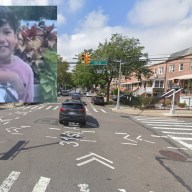By Bob Harris
The Queens Civic Congress, an umbrella organization of about 100 Queens civic associations, recently held a rally at Queens Borough Hall to call for quicker rezoning of various communities. For months, sometimes years, Queens neighborhoods have been waiting for promised street downzoning.
People bought homes in neighborhoods with certain styles and sizes of houses, trees, lawns and streets. The 1961 zoning resolution set city zoning, which was good, but the R2 zoning for one-family homes had loopholes which permitted builders to build larger houses.
Builders tore down stable houses and built larger buildings, called McMansions. These houses displaced trees, components of a good quality of life. Lawns and trees were replaced with cement or bricks. Walls were bricks, which held in heat. Rain swept down bricks or cement, flowing into sewers and backing up. The city Department of Buildings rubber stamped plans.
The DCP responded with a new zoning called R2A, eliminating R2 loopholes. A lot larger than 40 feet by 100 feet permits a larger house. If the DOB watches and enforces zoning laws, then passable houses can be built in residential neighborhoods with the quality of life being maintained.
A new law limits the amount of lawn area which can be paved. If the DOB checks submitted plans for the approval of new houses or enlargement of older houses, then checks to see what is built, one-family neighborhoods can be nice places to live and not overcrowded, flood prone areas.
One reason why these big houses were built and purchased was because of the lack of ethics of banks and mortgage brokers. People were given mortgages to build or buy houses when they could not afford them. Some brokers falsely filled in higher incomes for buyers or did not tell buyers or speculators the added fees or true mortgage costs. These fake money mortgages pumped into the economy as viable mortgages were sold to other organizations.
As fake house values went up, more people wanted to buy houses to enlarge or fix up and then flip to make a quick dollar. Some people wanted to live in a nice house in a nice neighborhood. Today we have the subprime crisis with houses vacant or partly built.
That QCC rally was to pressure the DCP to re-zone R2 neighborhoods to R2A. Some communities want R4, R5 or R6 zones lowered to fit the buildings already in them. Happily, the DCP has certified Laurelton and Waldheim to be rezoned to R2A if residents agree. Public hearings are being held. These zoning changes are only as good as new zoning enforcement. Builders who cheat or engineers who illegally self-certify an illegal structure have to be punished. A $5,000 fine on a $1 million building means nothing. Loss of a license means nothing when a son or cousin can certify construction.
City officials do not get that good zoning, proper zoning resolution enforcement and stern punishment creates public trust and maintains outer borough neighborhoods' quality of life.
GOOD AND BAD NEWS OF THE WEEK: About five decades ago, the city decided to tear down summer cottages and some permanent homes in Arverne in the Rockaways. The thought was good, but the city could not put it together, so miles of beachfront property became vacant.
For the last few years, they have been building in Arverne. They just opened a new development called “Arverne by the Sea.” The houses are selling in the upper $500,000 range. I get nervous when I see a 20-year real estate tax abatement and the advertisement that there is a rental apartment. One family says that it only has to pay $400 in taxes a year. Sounds familiar. With global warming and heavy storms, I hope the seawall is high enough.

































